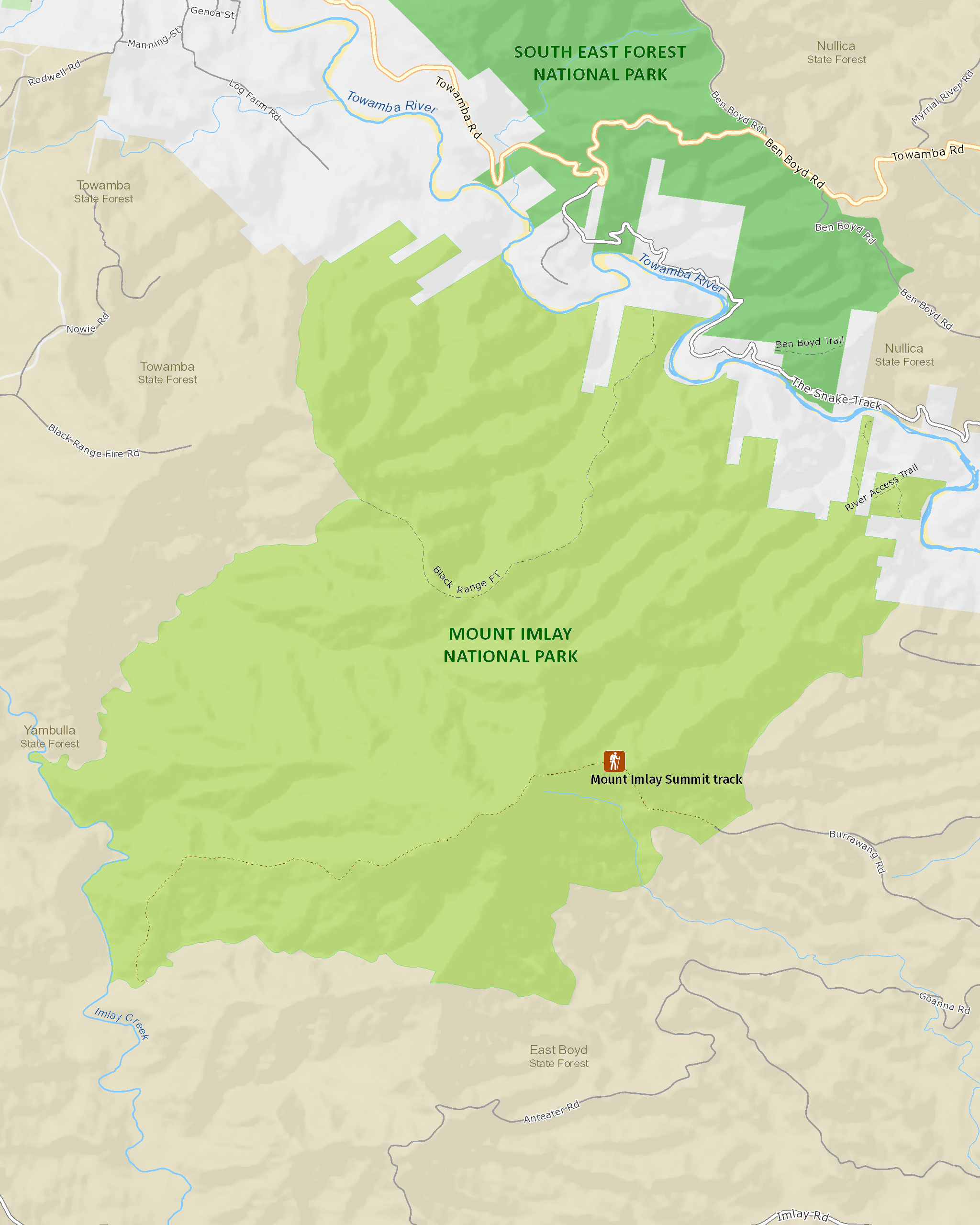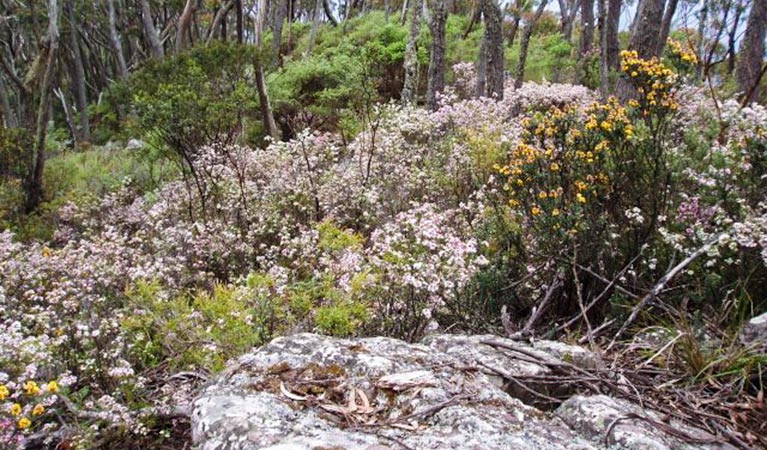Mount Imlay National Park
Overview
Just 30km south of Eden, Mount Imlay National Park is great for a day trip. Go for its picnicking, birdwatching, walking, wildflowers and coastal views.
Read more about Mount Imlay National Park
Mount Imlay National Park is a peaceful pocket of remote bushland, narrow rocky ridges and deep gullies, just 30km south of Eden on NSW’s far south coast. It’s a perfect place for those who want to get back to nature and bask in the peace and quiet of the bush.
The park is part of a system of national parks and reserves that protect the coastline and ranges between Moruya and the East Gippsland region of Victoria, along with nearby parks like South East Forests National Park and Nadgee Nature Reserve. As a symbol of this, its skyline is dominated by Mount Imlay, or ‘Balawan’, as it’s known to local Aboriginal people,
Take a scenic drive through the bush and spend the afternoon picnicking under the trees. If you’re a fit walker and up for a challenge, why not venture off and walk to the summit of Mount Imlay? You’ll enjoy birdwatching along the way and incredible filtered coastal views from the top.
Local alerts
For the latest updates on fires, closures and other alerts in this area, see https://www.nationalparks.nsw.gov.au/visit-a-park/parks/mount-imlay-national-park/local-alerts
Contact
- in the South Coast region
Mount Imlay National Park is always open but may have to close at times due to poor weather or fire danger.
-
-
Merimbula office
02 6495 5000
Contact hours: Monday to Friday and some weekends during peak holiday periods, 10am to 3pm. - 47 Merimbula Drive, cnr Sapphire Coast Drive, Merimbula NSW 2548
-
Email: npws.sapphirecoast@environment.nsw.gov.au
-
Merimbula office
Visitor info
All the practical information you need to know about Mount Imlay National Park.
Map

Map legend

Maps and downloads
Nearby towns
Eden (30 km)
Eden is a historic whaling town, ideal for a whale-watch tour. It's built around a promontory that juts into Twofold Bay.
Merimbula (57 km)
The main coastal towns of the Sapphire Coast include Bermagui, Tathra, Merimbula and Eden. This stunning coastline has sparkling beaches and bays, lakes and national parks, all accessible via excellent walking tracks and coastal drives. You'll find beaches just perfect for surfing, swimming and walks.
Bega (85 km)
With its forests, lush pastures and a coastline sculpted into a succession of wonders by the sea, the Sapphire Coast is a perfect holiday destination at any time of the year. Set in a valley at the junction of the Bega and Brogo rivers and surrounded by rich dairy country, Bega is a handsome, historic town that's the rural centre of the Sapphire Coast and gateway to the lush Bega Valley. Visit the Bega Cheese Heritage Centre, housed in a faithful reproduction of the original, tells the story of cheese-making production in the area.
Learn more
Mount Imlay National Park is a special place. Here are just some of the reasons why:
Exquisite growth and hidden wildlife

Many of the animals that make Mount Imlay their home are nocturnal, like the eastern pygmy-possum. But during the day, you could see red-necked wallabies, swamp wallabies, wombats and bush rats. If you're really lucky, you might even spot threatened species like the long-nosed potoroo, koala or the tiger quoll. Mount Imlay is a fantastic place for birdwatching, and you'll find a variety of birds like honeyeaters, currawongs and tree-creepers. As you wander through the forest, keep your ears and eyes out for lyrebirds fossicking in the understorey. And with a bit of luck, you might spot threatened species like the olive whistler, sooty owl and glossy black cockatoo. Mount Imlay is a botanical treasure of the far south east, where you'll find a number of threatened or biogeographically significant plant species, including the extremely rare Mount Imlay mallee and endangered Mount Imlay boronia. The bushland here also supports many native wildflowers, which come to life in spring and colour the bushland with purple, pink, yellow, white and red flowers.
- Mount Imlay – Balawan Summit walking track This challenging walking track climbs over 600m from Burrawang picnic area to the summit of Mount Imlay – Balawan. Enjoy a picnic with a view, spring wildflowers and birdwatching.
Band of brothers

Mount Imlay is named after the three Imlay brothers, who played an important part in opening the Eden-Monaro district to European settlement in the 1830s and 40s. Alexander, Peter and George Imlay arrived in Australia from Scotland in 1829, 1830 and 1833 respectively. Within a few years, they had established whaling, pastoral and trading enterprises near Twofold Bay at Eden and on the Monaro plains.
Aboriginal cultural heritage

Mount Imlay is known to local Aboriginal people as 'Balawan', and is a place of great spiritual significance. The mountain, surrounding gullies, forest and animals that make their home here are important to local Aboriginal culture and spiritual teachings.
Education resources (1)
What we're doing
Mount Imlay National Park has management strategies in place to protect and conserve the values of this park. View the detailed park and fire management documents.

